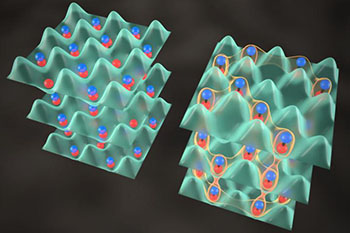
JILA scientists precisely overlapped two dense gases of ultracold potassium and rubidium atoms (left) to produce molecules that form an interconnected system (right), creating a new platform for studying quantum many-body interactions. [Image: Steven Burrows and Ye/Jin groups/JILA]
Researchers at JILA, the joint research institute of the U.S. National Institute of Standards and Technology and the University of Colorado, Boulder, have achieved the difficult feat of packing an optical lattice with a significant number of polar potassium-rubidium (KRb) molecules, to create a low-entropy quantum gas (Science, doi: 10.1126/science.aac6400). The resulting 3-D “quantum crystal,” according to the team, “extends the experimental toolkit” for studying spin physics, quantum magnetism and correlated many-body quantum behavior.
Tackling the reaction problem
The use of polar molecules such as KRb, rather than trapped atoms, as a platform for studying quantum many-body phenomena is attractive, because the molecules feature strong long-range dipolar interactions. But there’s a catch: trapped KRb molecules can react chemically with one another, especially under an electric field, which means that the trapped gas doesn’t stick around for very long.
One solution would be to confine the trapped polar molecules in deep potential wells in an optical lattice, at a high “filling fraction” (around 25 percent). That offers the best of both worlds, as it would keep the molecules from interacting chemically, but would still allow the long-range spin and dipole interactions required to address interesting quantum problems. But capturing individual bosonic Rb atoms and fermionic K atoms in a large number of lattice sites represents a formidable technical challenge, involving the creation, alignment, and marrying of two very different quantum gases of atoms into a single low-entropy assemblage of molecules.
Getting to 25 percent filled
To tackle the problem, the JIST team simultaneously loaded two different ultracold gases into the same 3-D optical lattice: a Bose-Einstein condensate of Rb atoms, and Fermi gas with a much larger number of K atoms. The design of the laser-induced optical lattice was set up so that the two clouds would spatially overlap at the center of the trap, allowing K and Rb atoms to occupy the same sites. The experimenters then deepened the optical lattice wells to pin the Rb atoms in place. While more than one of the bosonic Rb atoms could occupy a given site in the lattice, the fermionic K atoms were limited by Pauli blocking to a single atom per site.
Next, the team used magnetoassociation and optical techniques to nudge the aligned atoms into ground-state KRb molecules, and applied resonant light pulses to scrub the lattice clean of any remaining unpaired atoms. The team found that sites containing a single Rb atom would tend to form molecules with the K atoms, whereas sites with more than one Rb atom (or with none) would not. The result was a quantum crystal with KRb molecules at around a quarter of the lattice sites—achieving the desired 25 percent filling fraction.
At that level, according to team member Jun Ye, the crystal’s density is “high enough to introduce long-range order, so the molecules behave as an interconnected system instead of just a collection of isolated molecules.” That property, says Ye, will let researchers use the system to explore quantum connections in many-particle systems that “may lead to new materials.”
